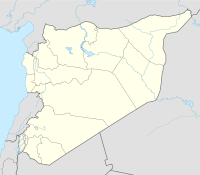
Back أفاميا Arabic افاميا ARZ Apameya (Suriya) Azerbaijani Апамея (Сірыя) Byelorussian Апамея Bulgarian Apamea Catalan Apameia am Orontes German Απάμεια (Ορόντου) Greek Apamea Esperanto Apamea (Siria) Spanish
 View of Apamea ruins | |
| Location | Hama Governorate, Syria |
|---|---|
| Region | Ghab plain |
| Coordinates | 35°25′05″N 36°23′53″E / 35.418°N 36.398°E |
| Type | settlement |
| History | |
| Builder | Seleucus I Nicator |
| Founded | ca. 300 BC |
| Abandoned | 13th century |
| Cultures | Hellenistic, Roman, Medieval Greek, Arab |
| Site notes | |
| Condition | ruins |
| Ownership | Public |
| Public access | Yes |
Apamea (Greek: Ἀπάμεια, Apameia; Arabic: آفاميا, Afamia), on the right bank of the Orontes River, was an ancient Greek and Roman city. It was the capital of Apamene under the Macedonians,[1] became the capital and Metropolitan Archbishopric of late Roman province Syria Secunda, again in the crusader period.
Amongst the impressive ancient remains, the site includes the Great Colonnade which ran for nearly 2 km (1.2 mi) making it among the longest in the Roman world and the Roman Theatre, one of the largest surviving theatres of the Roman Empire with an estimated seating capacity in excess of 20,000.
The site is about 55 km (34 mi) to the northwest of Hama, Syria, overlooking the Ghab valley.
- ^ (Stephanus of Byzantium s. v.; Strabo xvi. p. 752; Ptolemy v. 15. § 19; Festus Avienius, v. 1083; Anton. Itin.; Hierocles)
